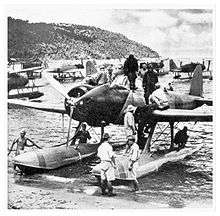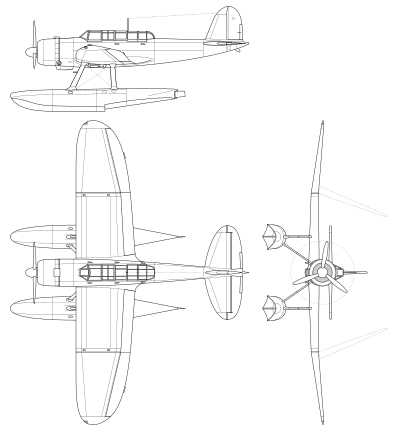Aichi E13A
The Aichi E13A (Allied reporting name: "Jake") was a long-range reconnaissance seaplane used by the Imperial Japanese Navy (IJN) from 1941 to 1945. Numerically the most important floatplane of the IJN, it could carry a crew of three and a bombload of 250 kg (550 lb). The Navy designation was "Navy Type Zero Reconnaissance Seaplane" (零式水上偵察機).
| E13A | |
|---|---|
 | |
| E13A1 in flight | |
| Role | Reconnaissance floatplane |
| Manufacturer | Aichi Kokuki KK |
| First flight | mid-late 1939 |
| Introduction | 1941 |
| Retired | 1945 |
| Primary users | Imperial Japanese Navy Air Service Royal Thai Navy |
| Number built | 1,418 |
Operational history
In China, it operated from seaplane tenders and cruisers. Later, it was used as a scout for the Attack on Pearl Harbor, and was encountered in combat by the United States Navy during the Battles of Coral Sea and Midway. It was in service throughout the conflict, for coastal patrols, strikes against navigation, liaison, officer transports, castaway rescues, and other missions, along with some kamikaze missions in the last days of war.
One Aichi E13A was operated by Nazi Germany alongside two Arado Ar 196s out of the base at Penang. The three aircraft formed the East Asia Naval Special Service to assist the German Monsun Gruppe as well as local Japanese naval operations.[1]
Eight examples were operated by the French Navy Air Force during the First Indochina War from 1945-1947,[2] while others were believed to be operated by the Naval Air Arm of the Royal Thai Navy before the war. One example captured by New Zealand forces was flown by RNZAF personnel in theatre, but sank and was not repaired after a float leaked.
Variants

- E13A1
Prototypes and first production model, later designated Model 11.[3]
- E13A1-K
Trainer version with dual controls
- E13A1a
Redesigned floats, improved radio equipment
- E13A1a-S
Night-flying conversion
- E13A1b
As E13A1a, with Air-Surface radar
- E13A1b-S
Night-flying conversion of above
- E13A1c
Anti-surface vessel version equipped with two downward-firing belly-mounted 20 mm Type 99 Mark II cannons in addition to bombs or depth charges
Production
- Constructed by Aichi Tokei Denki KK:133
- Constructed by Watanabe (Kyushu Hikoki KK):1,237[4]
- Constructed by Dai-Juichi Kaigun Kokusho: 48
Operators
- French Navy
- French Air Force - Captured Japanese aircraft.
- People's Liberation Army Air Force - surplus or derelict Japanese aircraft
Specifications (E13A1)

Data from Japanese Aircraft of the Pacific War[6]
General characteristics
- Crew: 3
- Length: 11.3 m (37 ft 1 in)
- Wingspan: 14.5 m (47 ft 7 in)
- Height: 7.4 m (24 ft 3 in)
- Wing area: 36 m2 (390 sq ft)
- Empty weight: 2,642 kg (5,825 lb)
- Gross weight: 3,640 kg (8,025 lb)
- Max takeoff weight: 4,000 kg (8,818 lb)
- Powerplant: 1 × Mitsubishi MK8 Kinsei 43 14-cylinder air-cooled radial piston engine
- Propellers: 3-bladed metal propeller
Performance
- Maximum speed: 376 km/h (234 mph, 203 kn) at 2,180 m (7,152 ft)
- Cruise speed: 222 km/h (138 mph, 120 kn) at 2,000 m (6,562 ft)
- Range: 2,089 km (1,298 mi, 1,128 nmi)
- Endurance: 14+ hours
- Service ceiling: 8,730 m (28,640 ft)
- Time to altitude: 3,000 m (9,843 ft) in 6 minutes 5 seconds
- Wing loading: 101.1 kg/m2 (20.7 lb/sq ft)
- Power/mass: 0.2163 kW/kg (0.1316 hp/lb)
Armament
- Guns: 1× flexible, rearward-firing 7.7 mm (.303 in) Type 92 machine gun for observer
Some aircraft fitted 2× 20mm Type 99-2 cannons in a downwards firing position in the belly
- Bombs: 250 kg (551 lb) of bombs
Surviving aircraft
The wrecks of a number of sunken aircraft are recorded. The wreckage of one aircraft is located on-land at an abandoned seaplane base at Lenger Island, off Pohnpei in the Federated States of Micronesia.[7]
One E13A was raised from where it sank and is displayed at the Kakamigahara Aerospace Museum, Kakamigahara, Gifu, Japan. However, it is reportedly in poor condition, lacking its engine, tail floats and one wing.[8]
See also
Aircraft of comparable role, configuration and era
- Arado Ar 196
- Aichi E16A
- Curtiss SOC Seagull
- Kawanishi E15K
- Northrop N-3PB
- Vought OS2U Kingfisher
- Yokosuka E14Y
Related lists
References
Notes
- Horst H. Geerken (9 June 2017). Hitler's Asian Adventure. BoD – Books on Demand. pp. 375–376. ISBN 978-3-7386-3013-8.
- Dorr and Bishop 1996, p. 234.
- Francillon 1979, p. 277.
- Francillon 1979, p. 281.
- World Air Forces – Historical Listings Thailand (THL), archived from the original on 25 January 2012, retrieved 30 August 2012
- Francillon 1979, pp. 277-281.
- "Aichi E13A1 Jake". Pacific Wrecks. 2017-05-22. Retrieved 2017-10-01.
- "E13A1 Jake Manufacture Number ?". Pacific Wrecks. 2017-05-22. Retrieved 2017-10-01.
Bibliography
- Dorr, Robert E. and Chris Bishop. Vietnam Air War Debrief. London: Aerospace Publishing, 1996. ISBN 1-874023-78-6.
- Francillon, Ph.D., René J. Japanese Aircraft of the Pacific War. London: Putnam & Company Ltd., 1970 (2nd edition 1979). ISBN 0-370-30251-6.
- Green, William. Warplanes of the Second World War, Volume Six: Floatplanes. London: Macdonald & Co. (Publishers) Ltd., 1962.
External links
| Wikimedia Commons has media related to Aichi E13A. |